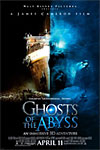Ghosts of the Abyss (PG) ★★★½
 Director James Cameron journeys back to the site of his greatest inspiration--the legendary wreck of the Titanic--and gives audiences a fresh new 3D experience.
Director James Cameron journeys back to the site of his greatest inspiration--the legendary wreck of the Titanic--and gives audiences a fresh new 3D experience.
Story
Hey, James, obsessed much? That's OK. You're not alone. The fate of the Titanic chills and mystifies us all--no matter how many times we hear the tale of how the giant, extravagant Ship of Dreams, deemed unsinkable by its creators, hit an iceberg on its maiden voyage from England to New York in 1912 and sank into the North Atlantic, killing nearly 1,500 people. For Cameron, delving into the history of this spectacularly built but ultimately doomed liner is both a passion and a career. First, in 1997, he made the highest-grossing film of all time; Titanic has earned approximately $1.8 billion and earned a bevy of Academy Awards, including Best Picture. Now, Cameron takes the world's foremost history and marine experts, his friend Bill Paxton and some state-of-the-art technology into the murky depths to explore the wreckage of the Titanic firsthand, inside and out, as never before--and he brings audiences along for the adventure.
Acting
It's clear from the start of Ghosts of the Abyss that everyone involved is very excited to be there, from the giddy Cameron to Titanic historians Ken Marschall and Don Lynch to microbiologist Lori Johnston, who's studying the ''rusticles'' eating away at the ship. They're clearly captivated by the story, which generates some interesting ''what if'' discussions among them: What if the ship hadn't been going so fast to make record time--and headlines? What if First Officer Murdoch had decided to steer the ship to the right instead of to the left of the iceberg? Should the lifeboats have gone back for the people floundering in the icy waters after the ship went down? Would the panicked souls have swamped the boats trying to get in? Or could they have organized the boats in such a way and in enough time to rescue more people? It's these kinds of questions that haunt us when we think about the Titanic, and they haunt this film. Our narrator on this trip, however, seems to have other things on his mind. As the layman of the group, Paxton's realistic reaction to diving thousands of feet underwater (''So, what level does the oxygen indicator have to go down to before we are in serious trouble?'') and his awe as he watches the Titanic loom out of the murky darkness perfectly capture our reactions as we sit in the theater watching. He just doesn't have to wear the dopey 3D glasses.
Direction
Of course, we do if want to get the full effect of the film, but at least Cameron only goes for the cheesy object-shooting-off-the-screen bit once. But that doesn't mean the experience of watching Ghosts of the Abyss isn't a visceral one. In fact, Cameron was so determined to show audiences the majesty of this sunken ship and to give us a bird's eye view of an exploration never before undertaken that he developed brand new 3D technology called the Reality Camera System to do it. I won't bore you with all the technical details about how it was created, but trust me--it works. You aren't necessarily aware of how 3D the documentary is; it simply makes you feel more there. It is truly mesmerizing to go down into the depths and float next to this massive iron shell of a ship, with little bubbles floating up in your periphery. Along with this new technology, Cameron also uses miniature ROVs (Remotely Operated Vehicles) called BOTS (later nicknamed Elwood and Jake) to explore the belly of Titanic, and some of the things they find will blow your mind: the stained glass windows of the dining room--still intact--or a stateroom with a wash basin still standing and a bowler hat still on the dresser. Scenes like these capture the grandeur of the ship--and confirm our sadness at the tragedy of its end.
Bottom Line
It's worth the risk of looking silly in the 3D glasses to join James Cameron on his trip to depths of the North Atlantic for a firsthand look at the great, tragic Titanic.
To get the full Quicklook Films experience, uncheck "Enable on this Site" from Adblock Plus
box office top 10

Civil War Released: April 12, 2024 Cast: Kirsten Dunst, Wagner Moura 11.1M

Abigail Released: April 19, 2024 Cast: Melissa Barrera, Dan Stevens 10.2M

Godzilla x Kong: The New Empire Released: March 29, 2024 Cast: Rebecca Hall, Brian Tyree Henry 9.5M

The Ministry of Ungentlemanly Warfare Released: April 19, 2024 Cast: Henry Cavill, Eiza Gonzalez 9M

Spy x Family Code: White Released: April 19, 2024 Cast: Takuya Eguchi, Saori Hayami 4.9M

Kung Fu Panda 4 Released: March 8, 2024 Cast: Jack Black, Viola Davis 4.6M

Ghostbusters: Frozen Empire Released: March 22, 2024 Cast: Paul Rudd, Carrie Coon 4.4M

Dune: Part Two Released: March 1, 2024 Cast: Timothée Chalamet, Rebecca Ferguson 2.9M

Monkey Man Released: April 5, 2024 Cast: Dev Patel, Sikandar Kher 2.2M

The First Omen Released: April 5, 2024 Cast: Nell Tiger Free, Bill Nighy 1.7M






